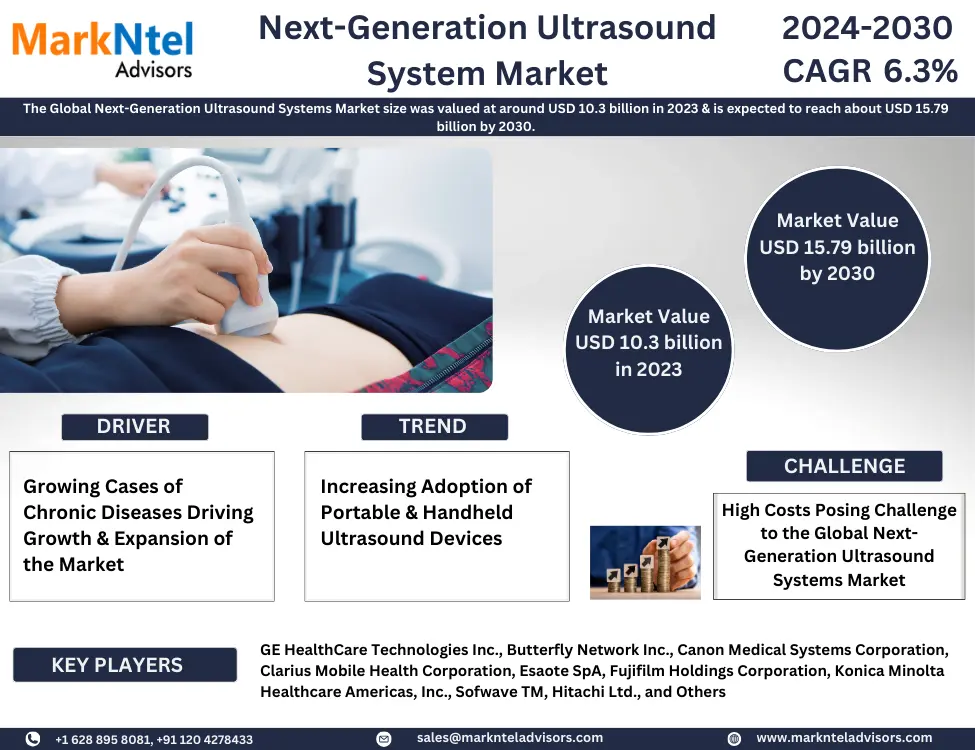Press Release Description
A USD 10.3 Billion Global Next-Generation Ultrasound Systems Market to Accelerate at a CAGR of Around 6.3% During 2024-30
The Global Next-Generation Ultrasound Systems Market size was valued at around USD 10.3 billion in 2023 & is expected to reach around USD 15.79 billion by 2030. The market is expected to grow at a CAGR of about 6.3% during the forecast period of 2024-30, cites MarkNtel Advisors in the recent research report.
In the past few years, the range of chronic diseases, including cardiovascular, kidney, etc., has covered most of the regions in the world due to some factors consisting of smoking, weight problems, and many others. This has expanded the pace of adoption of next-generation ultrasound systems for appropriate sickness analysis. Additionally, the surge in instances of road accidents has augmented the demand for next-generation ultrasound systems to nicely test fractures and other possible injuries. Along with this, there was growing participation in sports activities and different bodily activities, which has led to an escalation of muscle and other bone-associated injuries. The demand for next-generation ultrasound systems has thereby been growing to properly see the extent of injury.
With increasing awareness about congenital deformities and other birth-related complications, a higher number of pregnant women are moving towards routine ultrasound checks to closely monitor the progress of the fetus. As a result, the demand for other birth-related complications displayed an upward movement. Moreover, nowadays there have been some technological advancements, which include the improvement of portable & hand-held ultrasound devices. These technological improvements additionally accelerated the higher adoption of next-generation ultrasound systems in hospitals and clinical institutions as they provide point-of-care diagnostic applications.
Furthermore, the next-generation systems integrated into clinical settings often result in better patient outcomes. Hence, several companies across the globe, that were offering ultrasound systems, have started focusing on the launch of advanced next-generation solutions specific to different chronic diseases. This has led to the launch of more advanced and effective next-generation ultrasound systems globally. Moreover, in recent years, driven by the aim to improve public health, governments across countries have been investing in the set-up of newer hospitals, clinics as well as diagnostic centers. This is expected to generate more demand for next-generation ultrasound systems, further states the research report, “Global Next-Generation Ultrasound Systems Analysis, 2024.”

Segmentation Analysis
4D/3D Ultrasound Systems Segment Holds a Major Market Share
Based on the technology, the market is further bifurcated into, 4D/3D ultrasound systems, 2D ultrasound systems, and others (fusion imaging, tissue harmonic imaging, etc.). Out of them, the 4D/3D ultrasound systems hold a significant market share. The growing importance of 4D/3D ultrasound systems in accurately showing birth defects such as cleft palate which otherwise is not visible on standard ultrasound systems has largely augmented the adoption for the same. Further, as these systems allow one to see an unborn baby’s face for the first time, a significant proportion of pregnant women have been going for ultrasound examinations through 4D/3D ultrasound systems. This has positively driven the segmental market growth and its size.
Asia-Pacific Leads the Global Next-Generation Ultrasound Systems Industry
Asia-Pacific held the largest share of the Global Next-Generation Ultrasound Systems Market. This has been ascribed to the presence of a large number of patients with various chronic conditions requiring appropriate diagnosis via ultrasound systems. Also, the elderly population has significantly propelled the demand for next-generation ultrasound systems as they tend to suffer from multiple diseases frequently and require diagnosis often. The growth has been further ascribed to the development of various healthcare facilities in the region. Moreover, patients from across the world have been coming to countries such as India, Malaysia, etc. to receive affordable medical diagnostic and treatment services. This has augmented the growth of the Asia-Pacific Next-Generation Ultrasound Systems Market.
Competitive Landscape
With strategic initiatives, such as mergers, collaborations, and acquisitions, the leading market companies, including GE HealthCare Technologies Inc., Butterfly Network Inc., Canon Medical Systems Corporation, Clarius Mobile Health Corporation, Esaote SpA, Fujifilm Holdings Corporation, Konica Minolta Healthcare Americas, Inc., Sofwave TM, Hitachi Ltd., Hologic, Inc., Koninklijke Philips N.V., Samsung Electronics Co. Ltd., Shenzhen Mindray Bio-Medical Electronics Co., Ltd., Chison Medical Technologies Co., Ltd., Siemens Healthcare Private Limited, and others are looking forward to strengthening their market positions.
Key Questions Answered in the Research Report
- What are the industry’s overall statistics or estimates (Overview, Size- By Value, Forecast Numbers, Segmentation, Shares)?
- What are the trends influencing the current scenario of the market?
- What key factors would propel and impede the industry across the globe?
- How has the industry been evolving in terms of geography & solution adoption?
- How has the competition been shaping across various regions?
- How have the buying behavior, customer inclination, and expectations from product manufacturers been evolving during 2019-30?
- Who are the key competitors, and what strategic partnerships or ventures are they coming up with to stay afloat during the projected time frame?
We offer flexible licensing options to cater to varying organizational needs. Choose the pricing pack that best suits your requirements:
Buy NowNeed Assistance?
WRITE AN EMAIL
sales@marknteladvisors.comCustomization Offered
100% Safe & Secure
Strongest encryption on the website to make your purchase safe and secure
